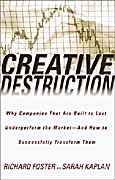An old maxim of the advertising industry is that someone must see and hear a commercial message at least seven times before he or she gets it. The same maxim seems to have infiltrated the world of management books. The favorite topic for the past few years has been the need for organizations to focus on transformation and innovation. “Change or die,” authors, consultants, and academicians warn. Dozens of books have found their way to bookstores all conveying a similar message, even if each book does so in a different way. The message itself is not new. More than 20 years ago, Peter Drucker wrote, “We must learn how to make existing companies capable of innovation where innovation means the systematic sloughing off of yesterday.” Other writers have picked up on this theme, including leading gurus such as Tom Peters (Thriving on Chaos) and Charles Handy (The Age of Unreason). Into this thicket come two consultants from Peters’ old firm, McKinsey, with their book Creative Destruction. Richard Foster, a managing director, and Sarah Kaplan, formerly an associate in the firm’s technology group, readily admit that the road they have gone down in this book has become increasingly congested. They acknowledge the contribution of Drucker, Peters and others. But then they take us all the way back to the 1930s and focus our attention on economist Joseph Schumpeter’s theory of creative destruction. While that phrase has been tossed around a great deal over the past few years in the technology industry, Foster and Kaplan explain what Schumpeter meant, and then take us inside dozens of different organizations to see how the theory has translated into practice. Foster and Kaplan start out by going over well-worn ground, observing that the typical lifespan of most companies has been shrinking at an increasing rate. A company bursts out of the gate with a better product or service, enjoys huge success for a short period of time, then crashes when an aggressive competitor comes along with a better and cheaper product or service. This pattern will continue and accelerate, stress Foster and Kaplan. The enormous growth of the venture capital industry will provide a steady stream of investment capital to anyone with a good business plan. No company is safe from attack. Foster and Kaplan, along with 50 colleagues from McKinsey, decided it would helpful for themselves and their clients to create a database to see if they could catalog and quantify information to help companies better identify where they were in the organizational cycle. The danger point they found was when a company had grown successful and the ABCs set in: Arrogance, Bureaucracy, and Complacency. The McKinsey Corporate Performance Database” provides the firm’s consultants with information about the performance of more than 1,000 companies in 15 industries over a 40 year time-span. A driving force in building the database, according to the authors, was the desire to measure objectively “good” and “poor” performance. Using information gleaned from the database, Foster and Kaplan put the challenge squarely before us: “So great is the challenge of running the operations of a corporation today that few corporate leaders have the energy or time to manage the processes of creative destruction, especially at the pace and scale necessary to compete in the market. Yet that is precisely what is required to sustain market levels of long-term performance.” Maintaining a high level of energy, determination and commitment to constant change and innovation is exceedingly difficult, but it not simply the best path for continuous success, it is the only path. Possibly one of the most insightful questions any senior manager can ask himself is the one the authors found that Intel head Andy Grove asked then-CEO Gordon Moore back in 1984 when the company was floundering, “If we got kicked out and the board brought in a new CEO, what do you think he would do?” They realized that the answer to the question involved abandoning Intel’s core business at the time, the production of memory chips. But Grove responded, “Why shouldn’t you and I walk out that door, come back in, and do it ourselves?” That is precisely what they did. This may be what top executives need to do on the first day of each month: fire themselves and then rehire themselves to “correct” whatever mistakes they had made and to “repair” flawed strategies. In Intel’s case, Grove and Moore made the difficult decision to eliminate what was for Intel at the time their core business. Foster and Kaplan believe that had they not made that decision, the company almost certainly would have failed. The authors wallow in too much jargon; the book would have been better if an editor had been more actively engaged in the creative destruction of turgid writing. But the authors’ point is clear and important: Companies need to learn to “act like the market.” The marketplace changes at an accelerating rate. Companies have a choice of changing ahead of the marketplace, with the marketplace, or falling behind. In order to assure that a company changes with the marketplace, senior management must change the company’s mental models continuously. The architecture of the successful company will make creation and destruction the highest priority. Foster and Kaplan draw their book to a close with a quote from Schumpeter, written in 1939: “it is not [price and output] competition which counts, but the competition from the new commodity, the new technology, the new source of supply, the new type of organization.” We have heard this type of quote so often that we are in danger of becoming deaf to its importance. Foster and Kaplan offer little new or original in this book, but they do reinforce a lesson far too many organizations still have not grasped. Perhaps there is something to the ad industry’s maxim.
Looking for more insights?
Sign up to stay informed about our latest article releases.



